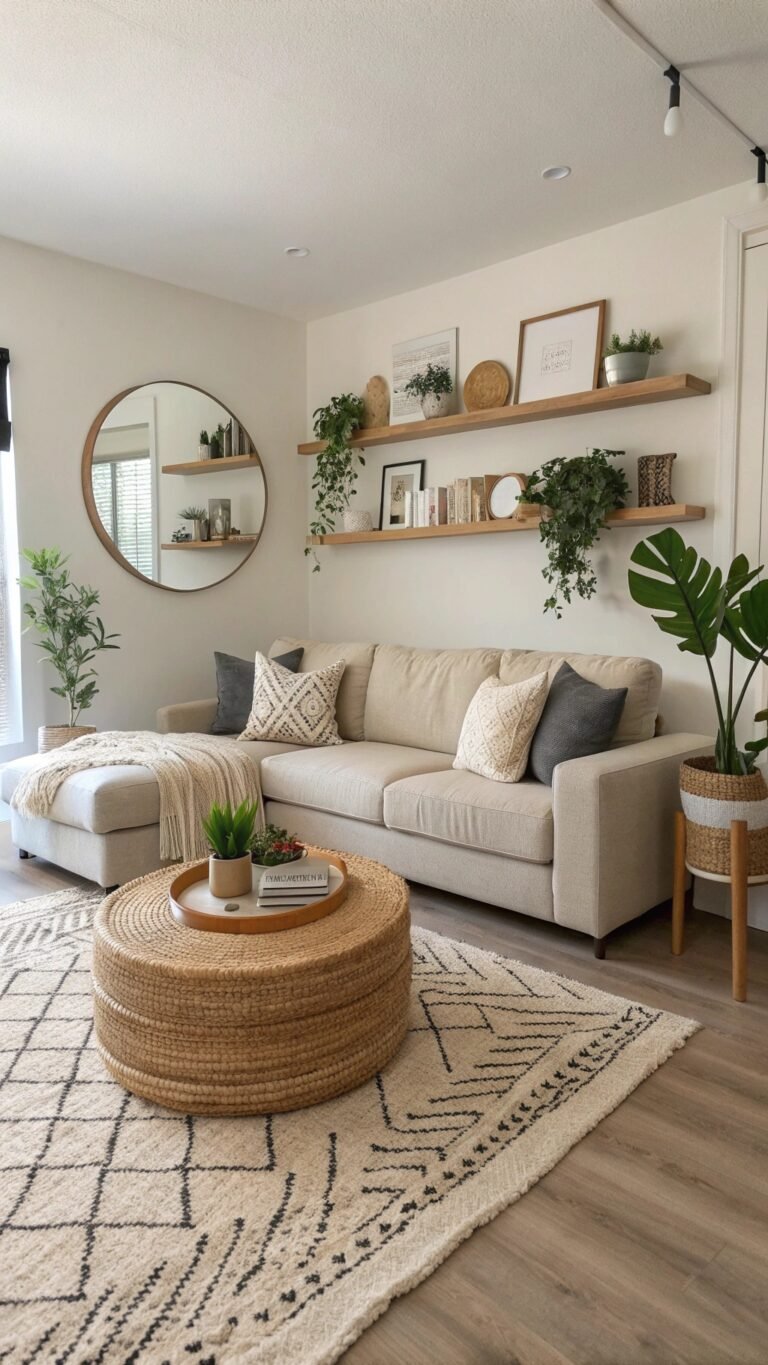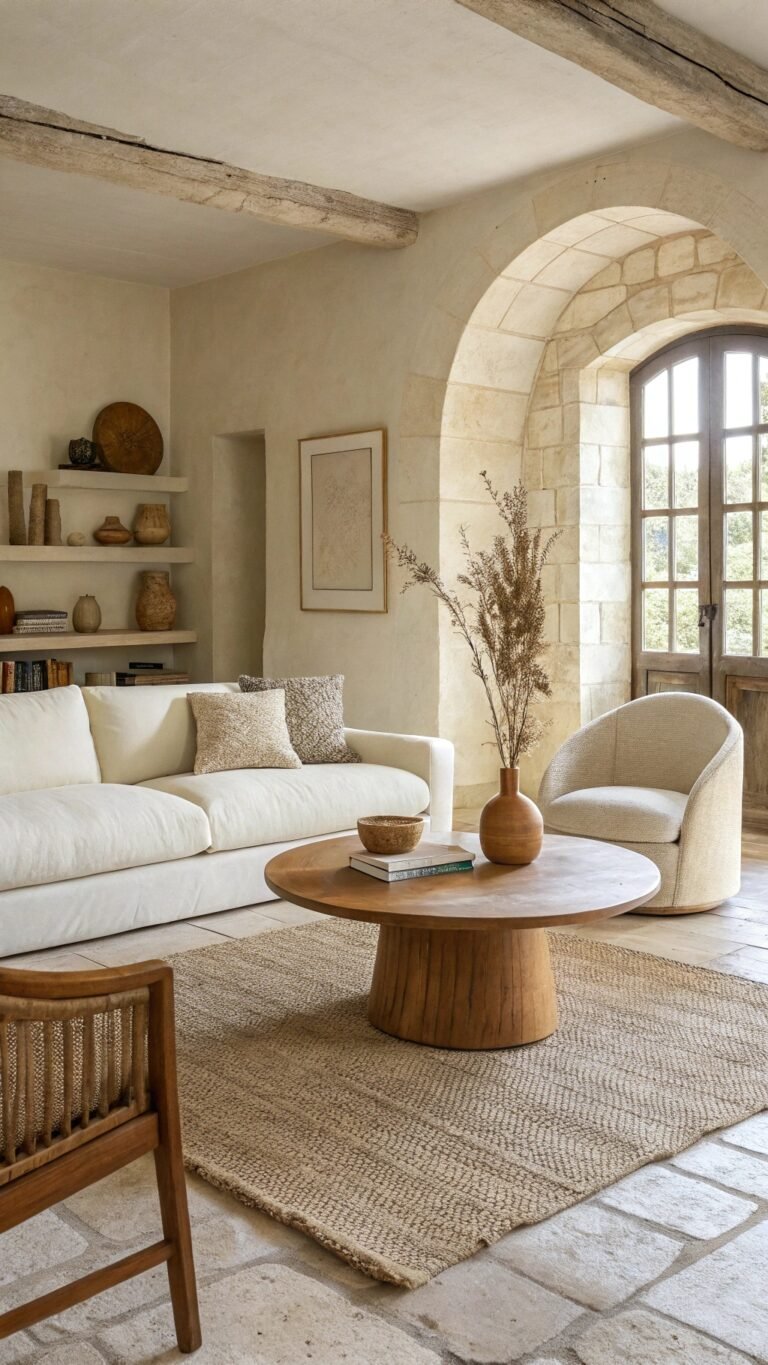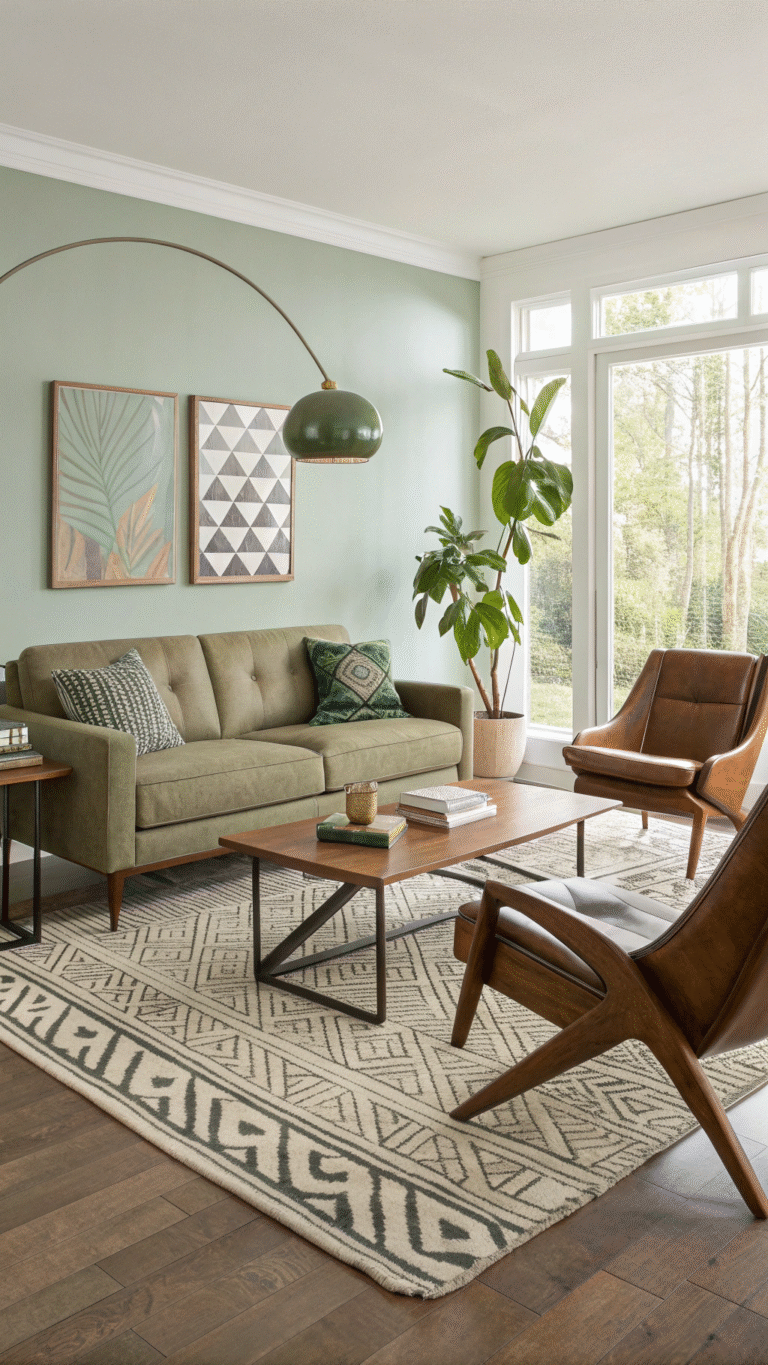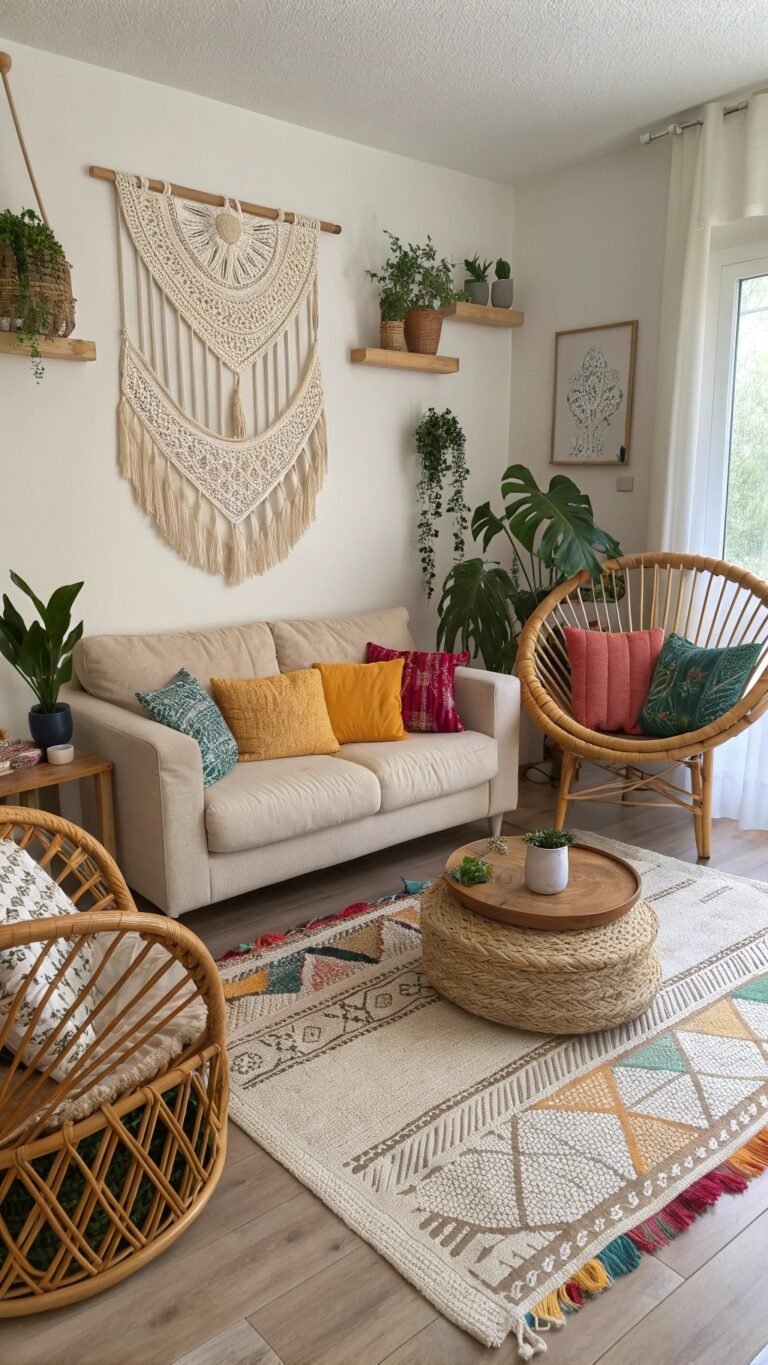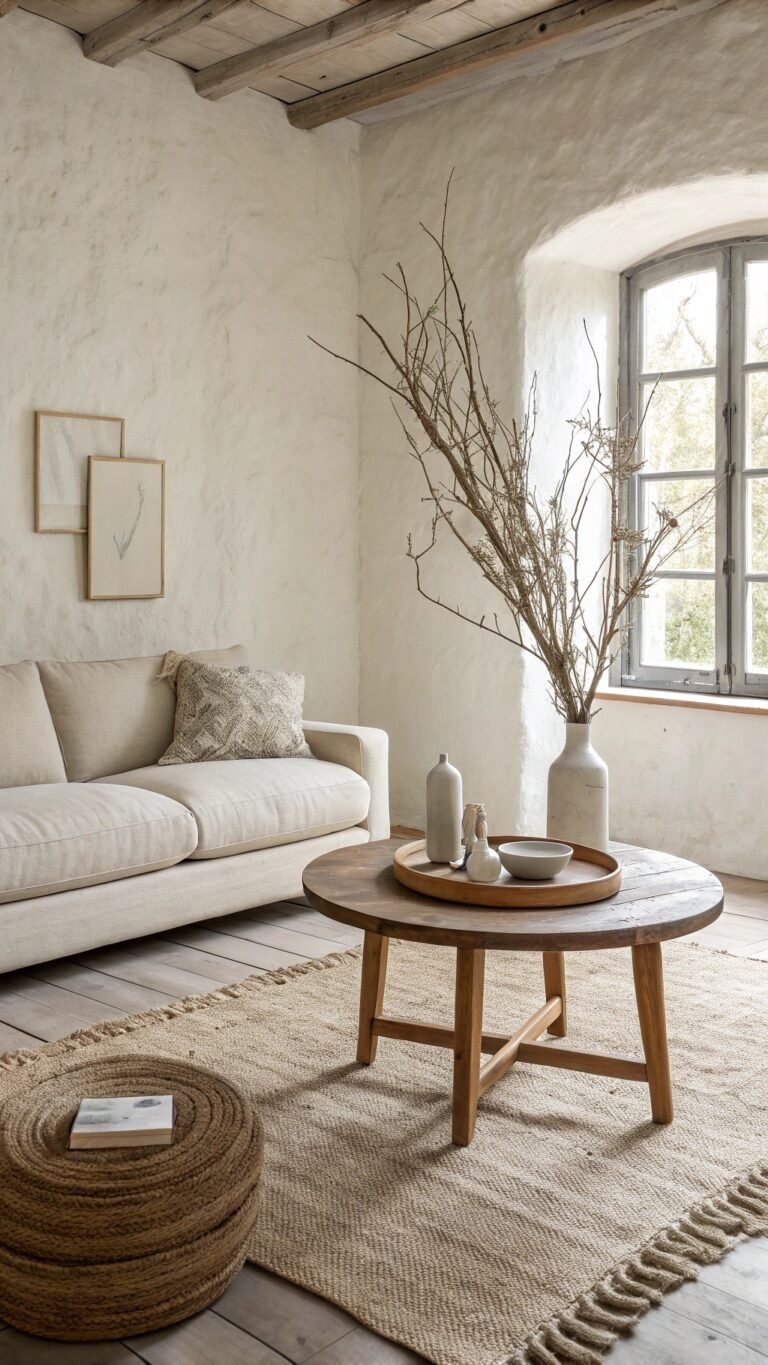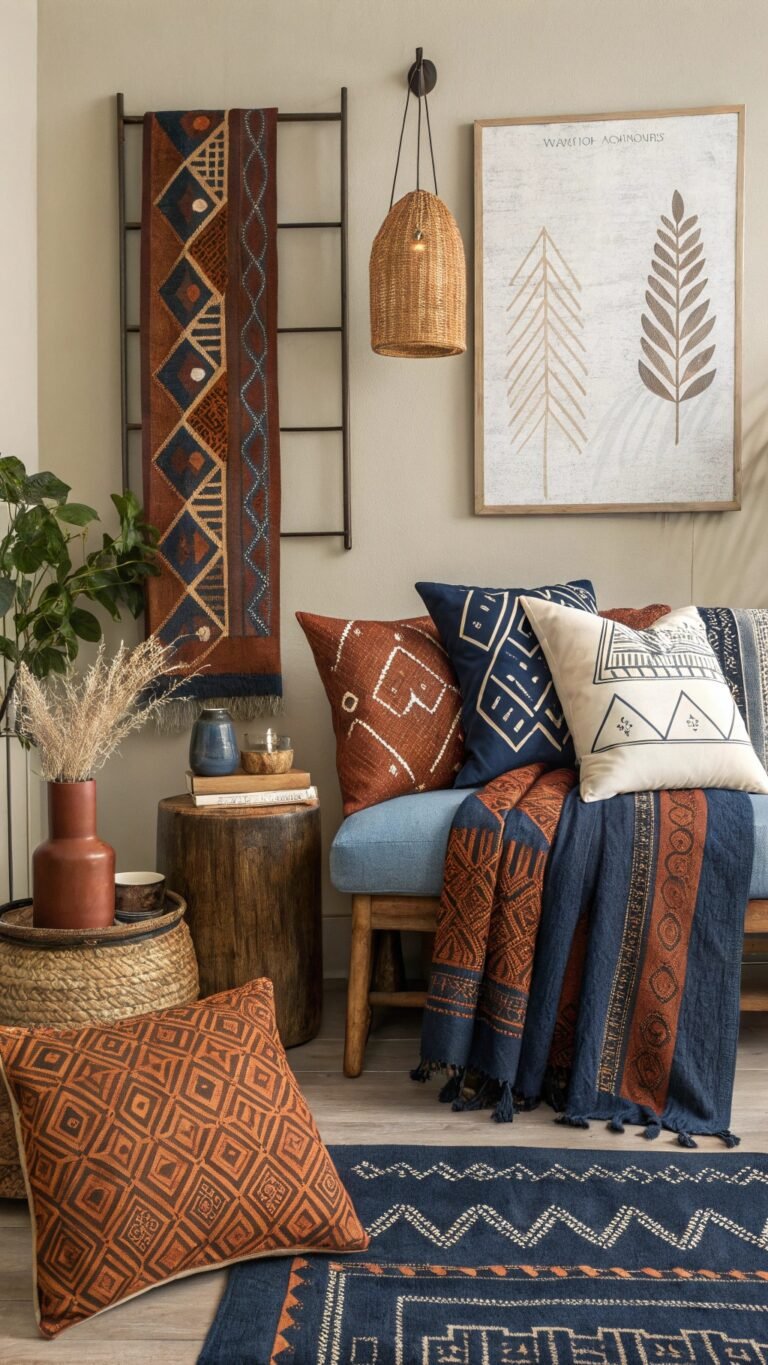Living Room Inspiration: 16 Ideas That Feel Fresh and Live Well
Living room inspiration is the decor trend to watch because small, strategic changes create magazine-level impact without major renovations. Designers are leaning into texture-forward neutrals, sculptural silhouettes, layered lighting, and greener materials.
Mix one headline move—color, cabinetry, or lighting—with two easy tweaks, and your lounge will look sharper and function better every single day.
1) Soft Neutral Lounge Layers
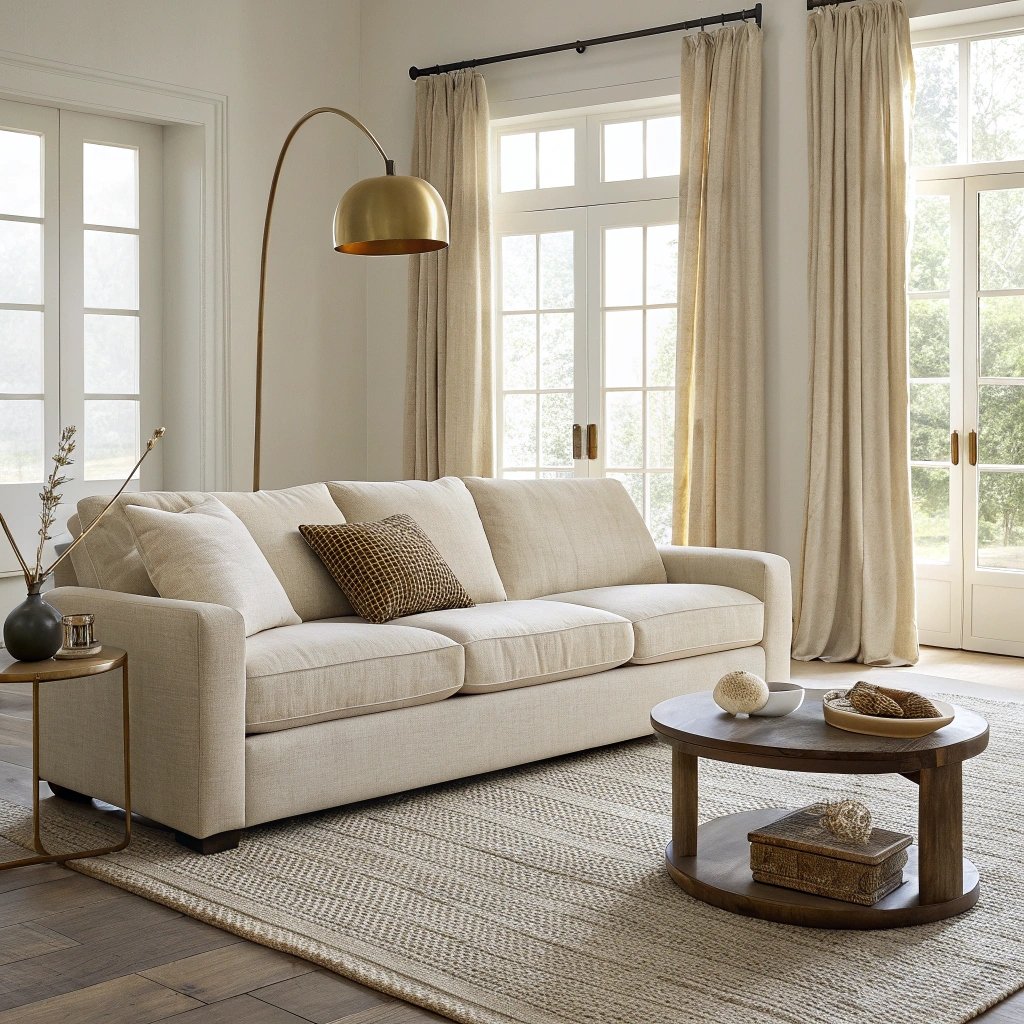
Calming rooms start with a tight palette—bone, oat, warm white—and let texture do the talking. Anchor with a low, deep sofa, add a chunky wool rug, and layer linen curtains that skim the floor.
Float furniture off the walls to improve flow, and keep surfaces edited: a stone tray, two books, and one sculptural object are enough.
What makes something unique:
Vary sheen inside the same palette for depth: matte walls, nubby textiles, and soft-lustre ceramics.
Introduce a single warm metal—brushed brass or bronze—on a floor lamp and picture frame to “glaze” the space without shine overload.
This restraint reads luxurious, photographs beautifully, and stays easy to maintain when life gets busy.
2) Saturated Color-Block Wall
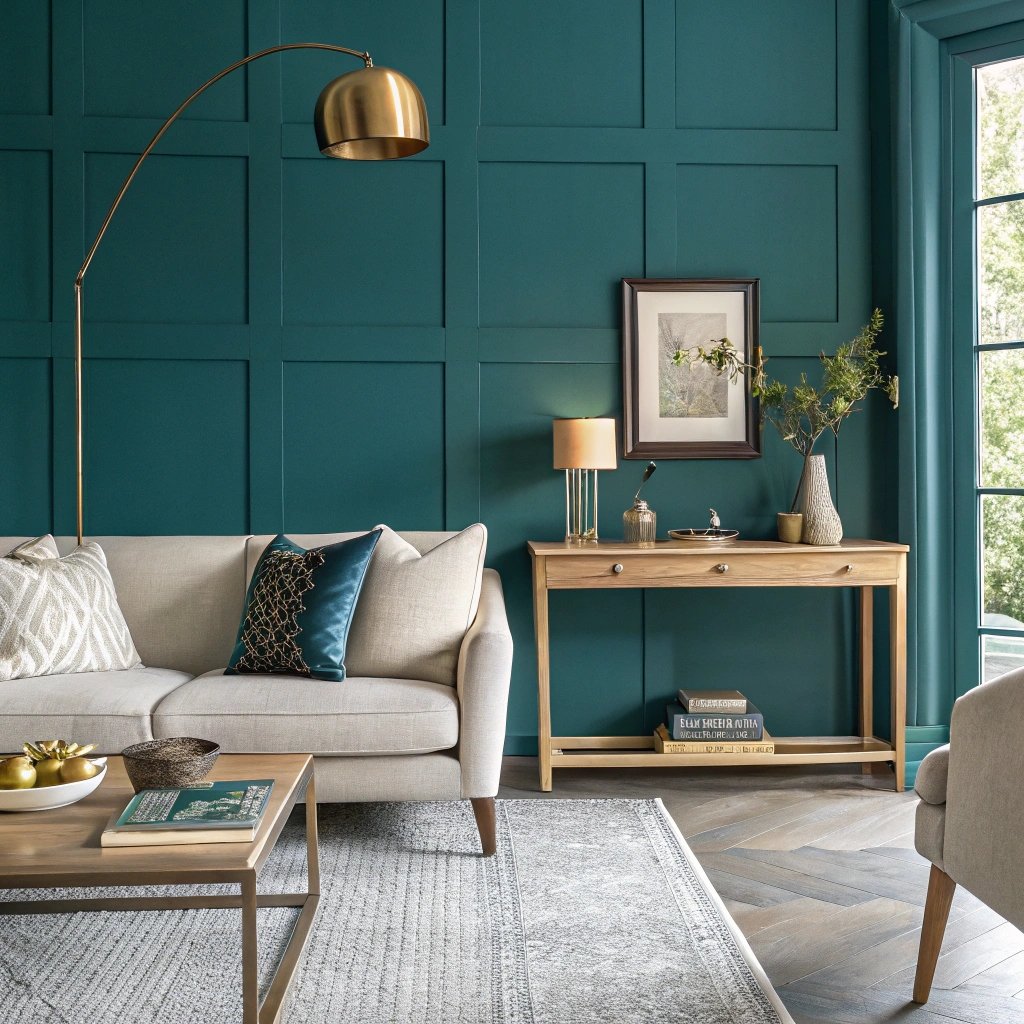
A single color-drenched wall can reset proportions and deliver personality. Choose deep teal, oxblood, or heritage green behind the sofa to frame seating and reduce the need for heavy art.
Keep adjacent walls pale; echo the bold hue once more on a throw or lamp base so the statement feels intentional, not loud.
What makes something unique:
Play with sheen to avoid flatness: matte on the wall, satin finish on a color-matched console, and a slightly glossier lacquer picture frame.
Warm woods and off-white textiles ground the intensity. The controlled block hides outlets and cords visually and turns everyday furniture into a curated vignette.
3) Curved Furniture & Soft Geometry
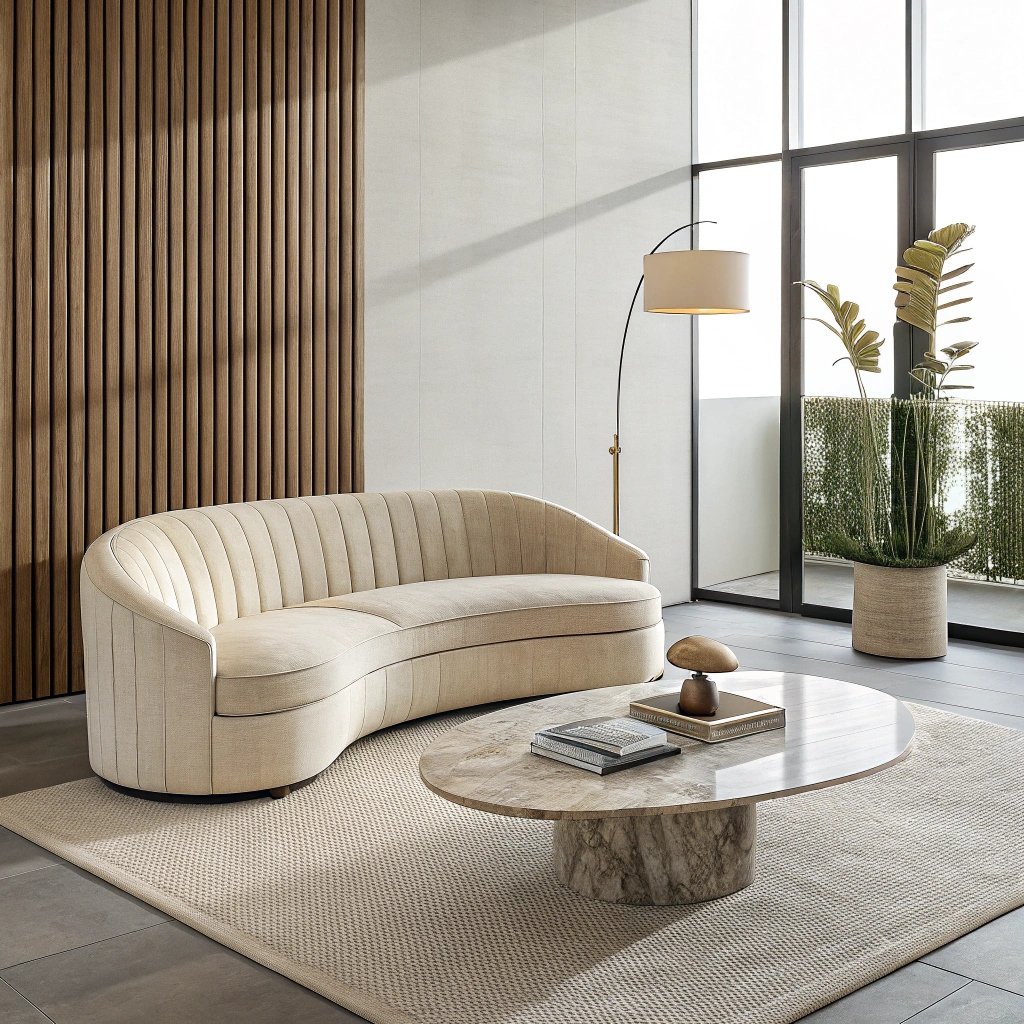
Trade hard angles for gentle arcs that relax the eye and improve traffic flow. A radius sofa, rounded coffee table, and mushroom-shade lamps soften corners and invite conversation.
Curves visually “pull” pieces together, letting you place furniture closer without feeling cramped—ideal for small or open-plan rooms.
What makes something unique:
Echo the curve three times—sofa, table, lamp—to create cohesion. Pair rounded forms with linear backdrops like slatted wood or framed paneling for contrast.
The interplay keeps the room modern, not saccharine, and the softer silhouettes are friendlier to kids and high-traffic spaces.
4) Warm Minimalist Scandi
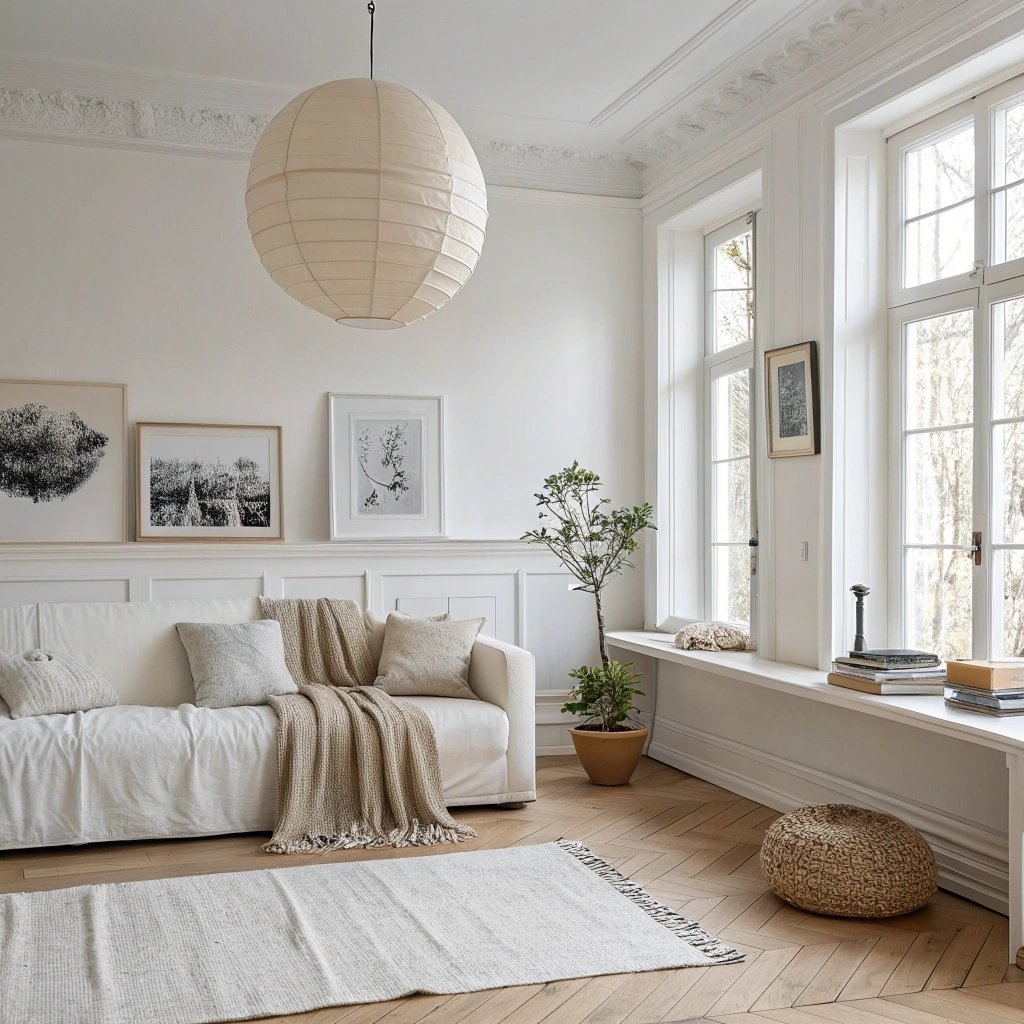
Scandi doesn’t mean stark. Mix pale woods, matte whites, and wool textures with one vintage piece for soul.
Streamline the layout—sofa, side chair, light wood coffee table—then add a paper-lantern pendant for warm, flattering light. Keep styling light so negative space can breathe and make the room feel larger.
What makes something unique:
Prioritize tactile honesty: oil-finished oak, linen slipcovers, and felted wool throws. Use peg rails or a slim picture ledge for flexible displays that never clutter.
The focus on materials over ornament makes seasonal updates effortless—swap a throw, not furniture.
5) Modern Traditional (Transitional)
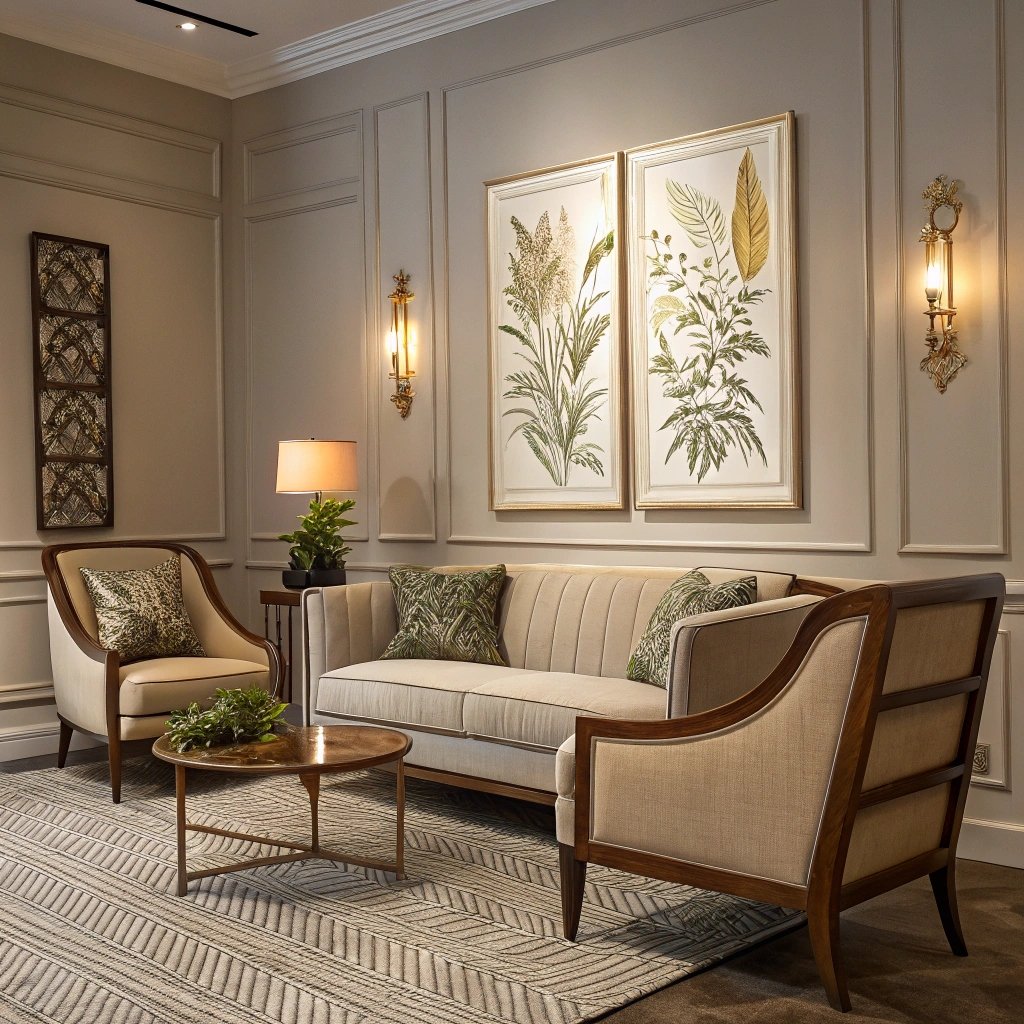
Blend clean lines with classic detailing for a look that feels current but timeless. Keep a tailored sofa, add spindle or turned-wood occasional chairs, and use a brass picture light over restrained art.
Moldings painted in the wall color add depth without fuss. Patterns stay subtle—pinstripe, herringbone, or petite florals in muted tones.
What makes something unique:
Repeat traditional forms in modern finishes—antique-inspired lamp shapes in matte ceramic, or a gallery-style frame on botanical prints.
This respectful remix avoids pastiche and feels naturally collected, making the room age gracefully as you layer memories.
6) Art-Led Salon Wall
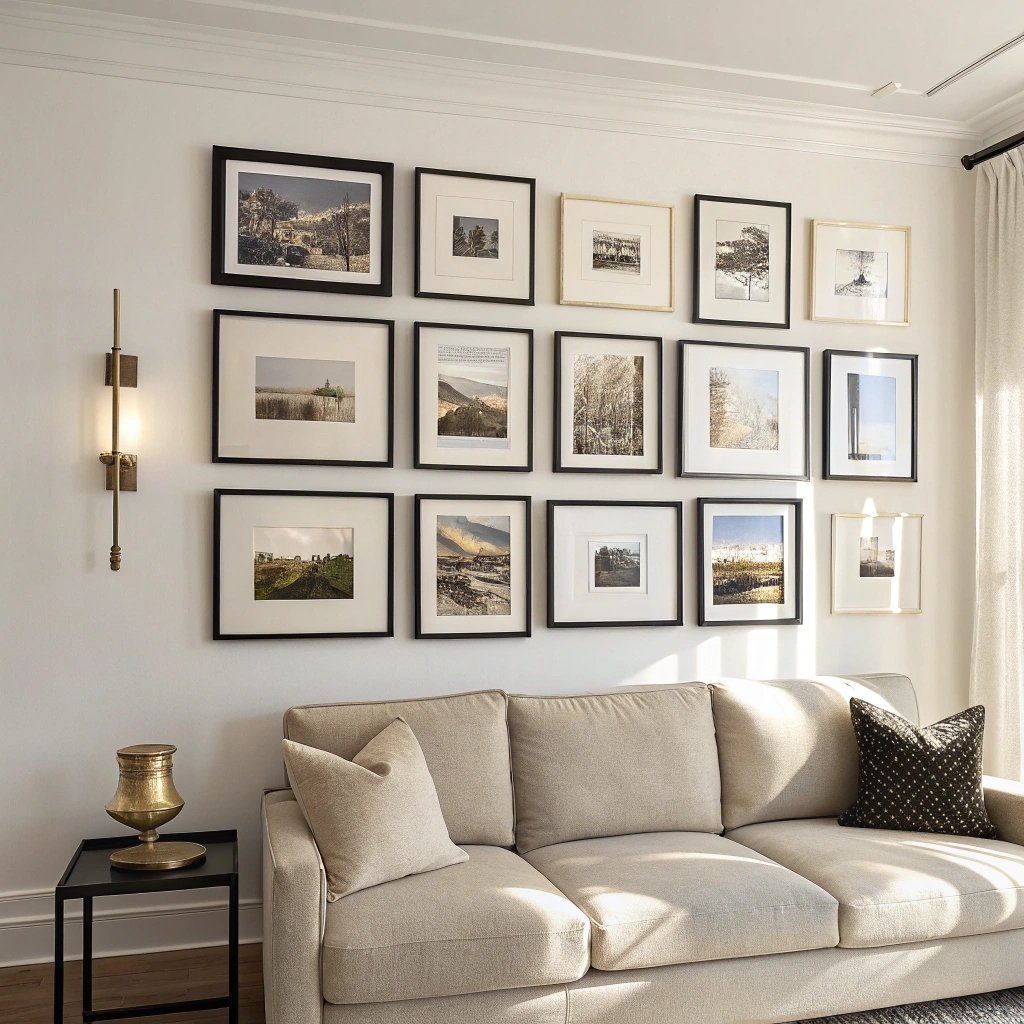
Turn a blank wall into a personality piece with a tight, cohesive gallery. Mix sizes, keep frames slim and consistent, and align a strong centerline.
Layer one sculptural sconce to add dimension and evening glow. The arrangement becomes a backdrop that supports any sofa or chair you place beneath it.
What makes something unique:
Limit the palette of the art—three tones max—so composition trumps chaos. Include a tactile element like a small textile or relief to break the plane.
The curated restraint feels boutique, not dorm-room, and adapts as you rotate pieces over time.
7) Biophilic Green Corner
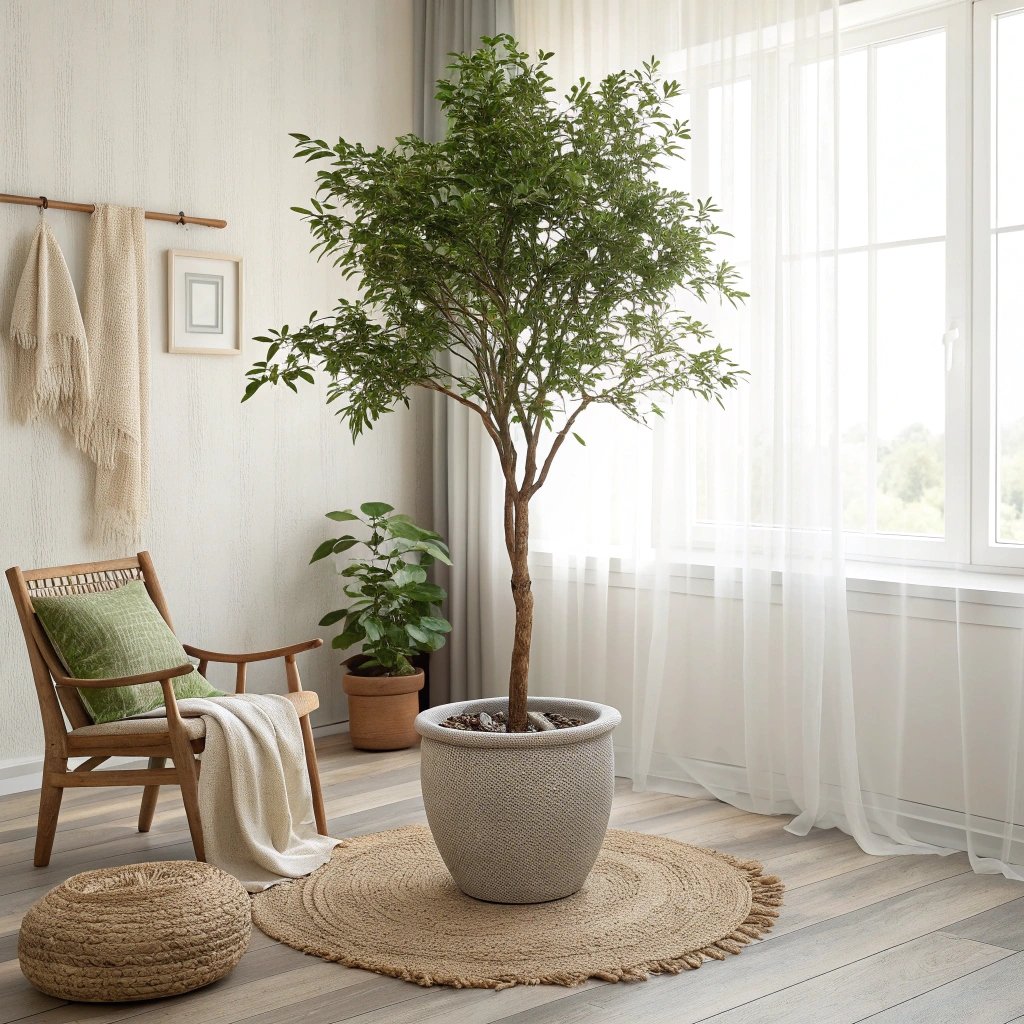
One or two substantial plants—olive tree, ficus, or rubber plant—soften edges and introduce organic movement.
Pair with a natural fiber rug, linen drapery, and a stone side table for an easy indoor-outdoor dialogue. Keep planters matte and simple so foliage remains the star.
What makes something unique:
Position plants where they graze light and cast gentle shadows on walls. Add a low uplight on a timer for evening drama that doubles as mood lighting.
This corner becomes a living sculpture that changes with the seasons and refreshes the entire room without new purchases.
8) Textural Mix: Bouclé, Wood, and Stone
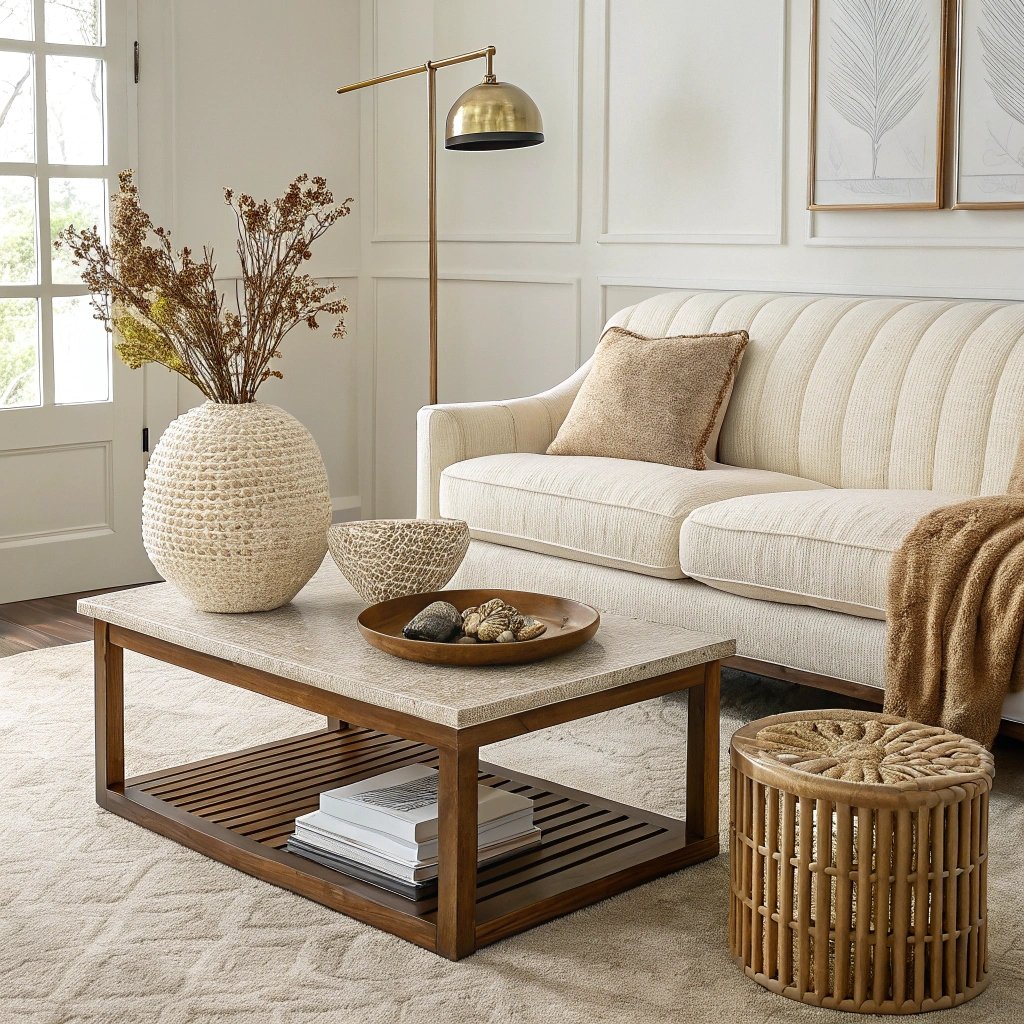
Texture makes neutrals interesting. Combine a bouclé or chenille sofa, oak or walnut tables, and a travertine or limestone top.
Add ribbed ceramics and woven baskets for subtle rhythm. Keep metals warm and low-sheen so everything feels tactile rather than glossy.
What makes something unique:
Repeat each material at least twice for intentionality—wood legs and a wood console, stone tabletop and stone tray.
The echo reads curated and increases perceived quality. It’s a richness you can feel, not just see.
9) Low-Slung Conversation Setup
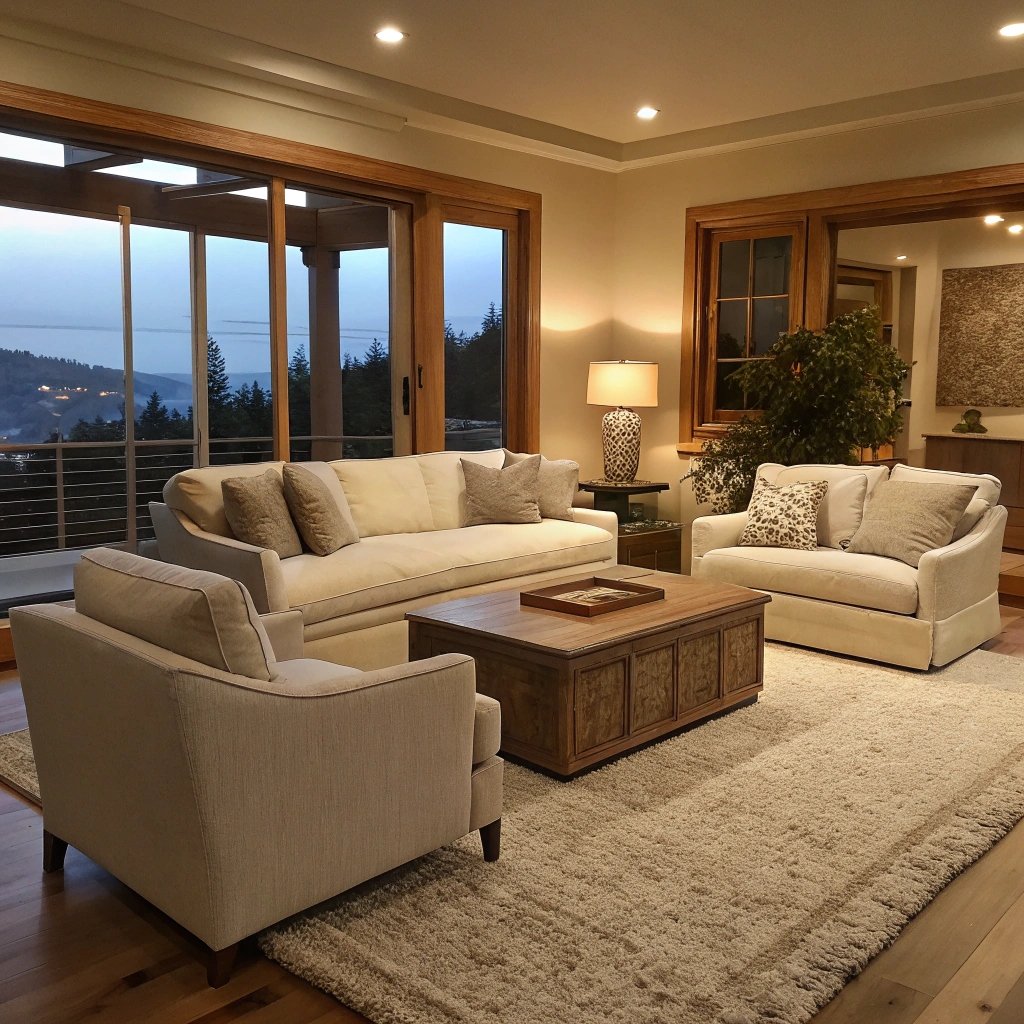
Lower profiles open sightlines and create intimacy. Use a low sofa, armless slipper chairs, and a wide, low table.
Keep art small and near the seating line so the visual weight stays grounded. This arrangement works wonders in rooms with low ceilings or awkward windows.
What makes something unique:
Add a plush, thick-pile rug to enhance the “sunken” feel without construction. A perimeter picture ledge at seat height holds books and candles while keeping the floor clear. The room feels cozy, cinematic, and unexpectedly generous.
10) Small Living Room, Smart Moves
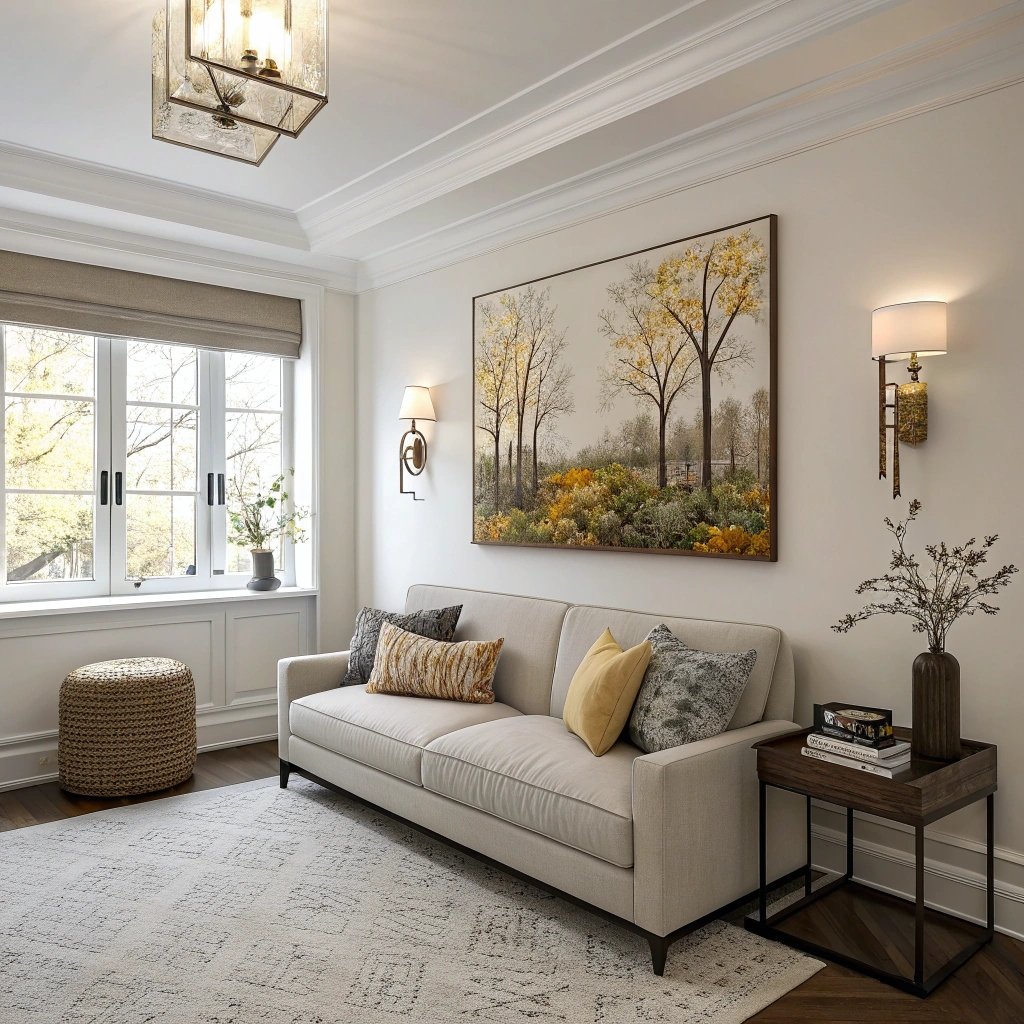
Scale furniture thoughtfully: a narrower sofa with slim arms, nesting tables instead of one large piece, and wall-mounted lighting to free tabletops.
Mirrors placed opposite windows widen the view; a single large artwork keeps focus, reducing cluttered sightlines.
What makes something unique:
Swap swing doors for sliders or use a color-matched pocket door to reclaim layout options. A window bench with drawers adds seating and storage without new footprints. The space reads edited and intentional, proving small can still be sophisticated.
11) Disciplined Pattern Play
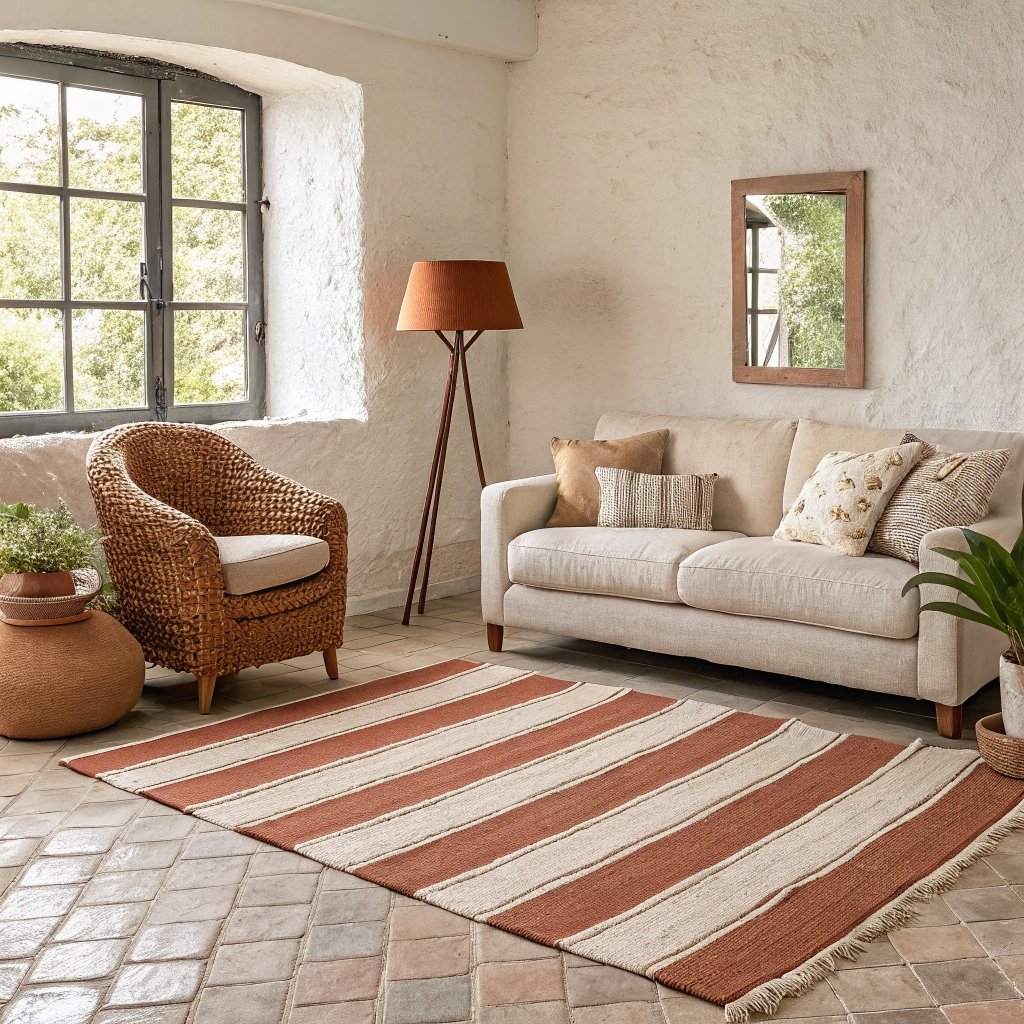
Love pattern? Keep it controlled. Choose one hero moment—a striped rug or block-printed drapery—and let everything else support it in solids.
Repeat a color thread across pillows and a ceramic lamp base so the look feels cohesive, not busy.
What makes something unique:
Balance visual energy with texture—bouclé chair, linen sofa, matte plaster wall—so pattern reads sophisticated. Limit the palette to three tones. The discipline preserves calm and makes the statement impossible to miss.
12) Monochrome with Metal Accents
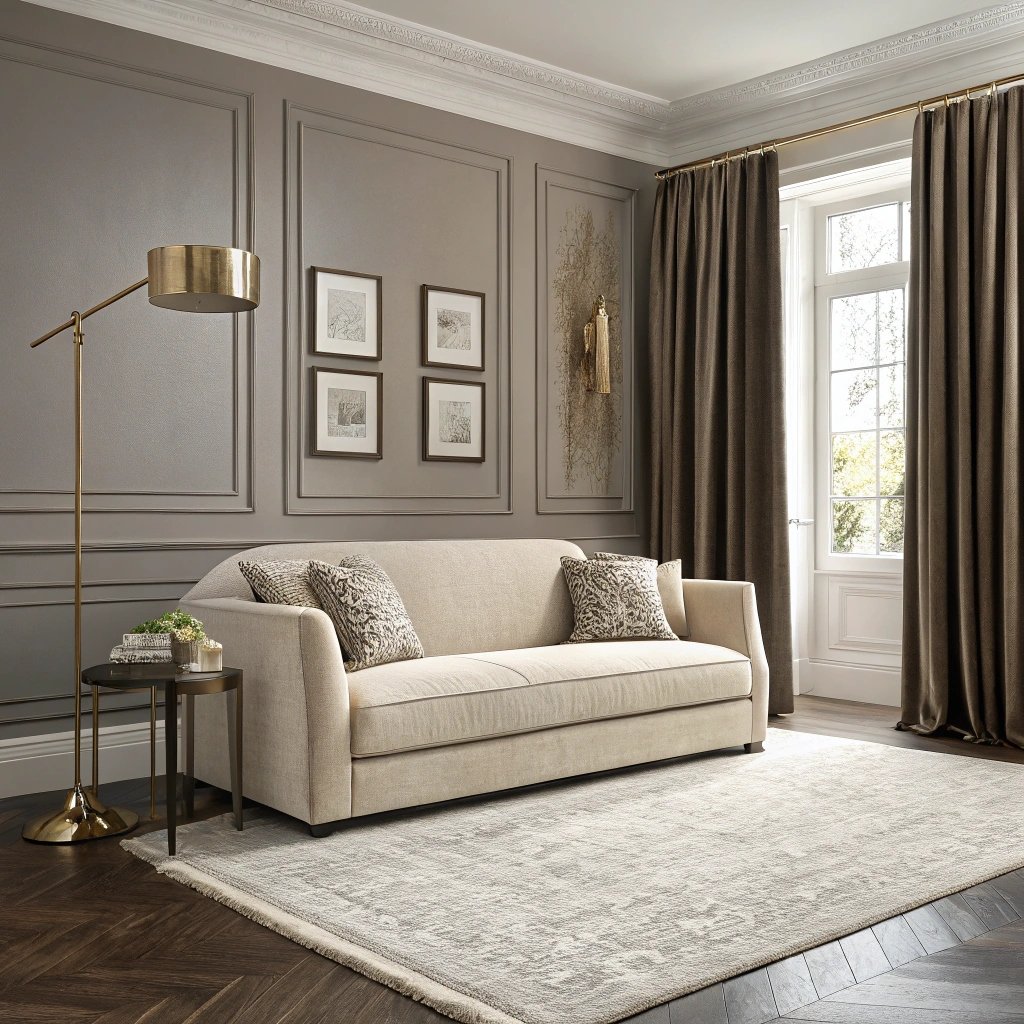
Choose one hue—greige, charcoal, or mushroom—and run it across walls, drapery, rug, and major upholstery.
Introduce a single metal in small, repeated hits: slim brass frames, a picture light, and a graceful floor lamp. Monotone calms the room while metal catches light like jewelry.
What makes something unique:
Vary material texture within the color family—velvet pillow, linen sofa, wool rug—so the monochrome never falls flat. The restrained sparkle of metal elevates the palette without breaking the spell.
13) Built-Ins and Books, But Airy
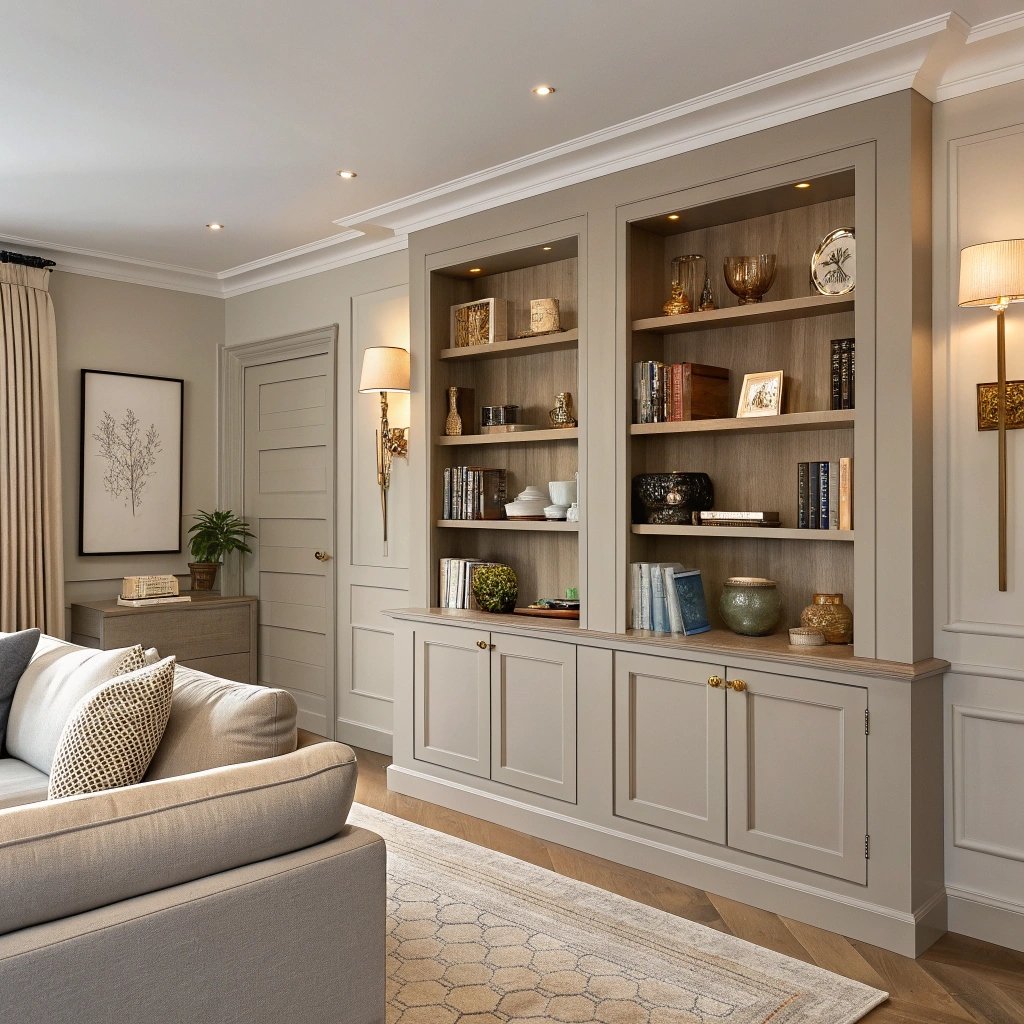
Floor-to-ceiling built-ins add storage and personality. Paint them to match the walls so they read architectural, not bulky, and style shelves with generous negative space.
Mix vertical books, horizontal stacks, and a few ceramics; hide less-pretty items behind lower doors.
What makes something unique:
Add integrated picture lights or shelf LEDs for museum-level glow at night. A library ladder or slim rail adds charm and usefulness if ceilings are high.
The system becomes the room’s backbone, keeping clutter at bay while showcasing what you love.
14) Breezy Coastal Naturals
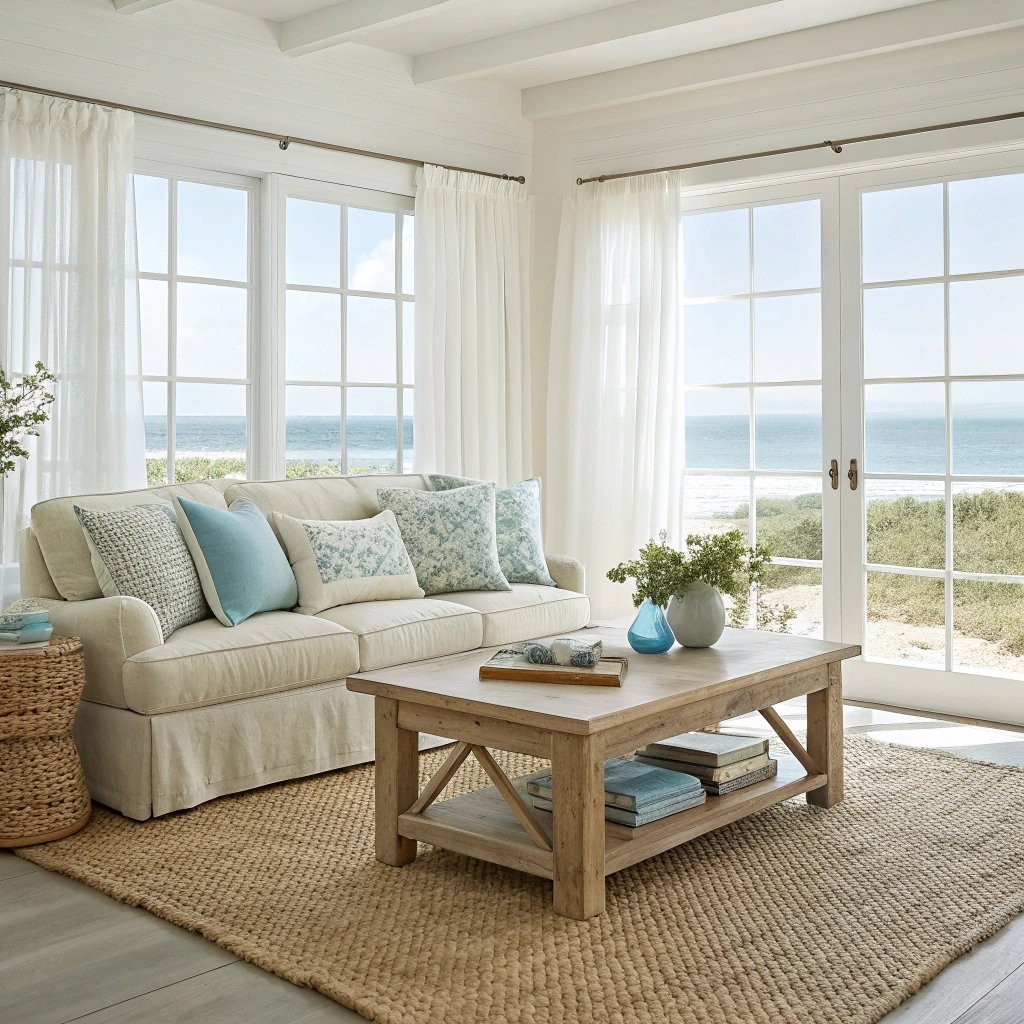
Channel light and air without clichés. Use sand-toned linens, bleached oak, woven seagrass, and chalky ceramics.
Keep blues muted—slate, sea glass—so the palette feels adult. Sheer curtains invite movement; a textured plaster or limewash wall adds coastal softness without shells.
What makes something unique:
Avoid theme overload by repeating the same few materials in different scales—large seagrass rug, small woven tray, oak coffee table. The restraint lands breezy, not kitschy, and adapts easily inland or city-side.
15) Soft Industrial Loft
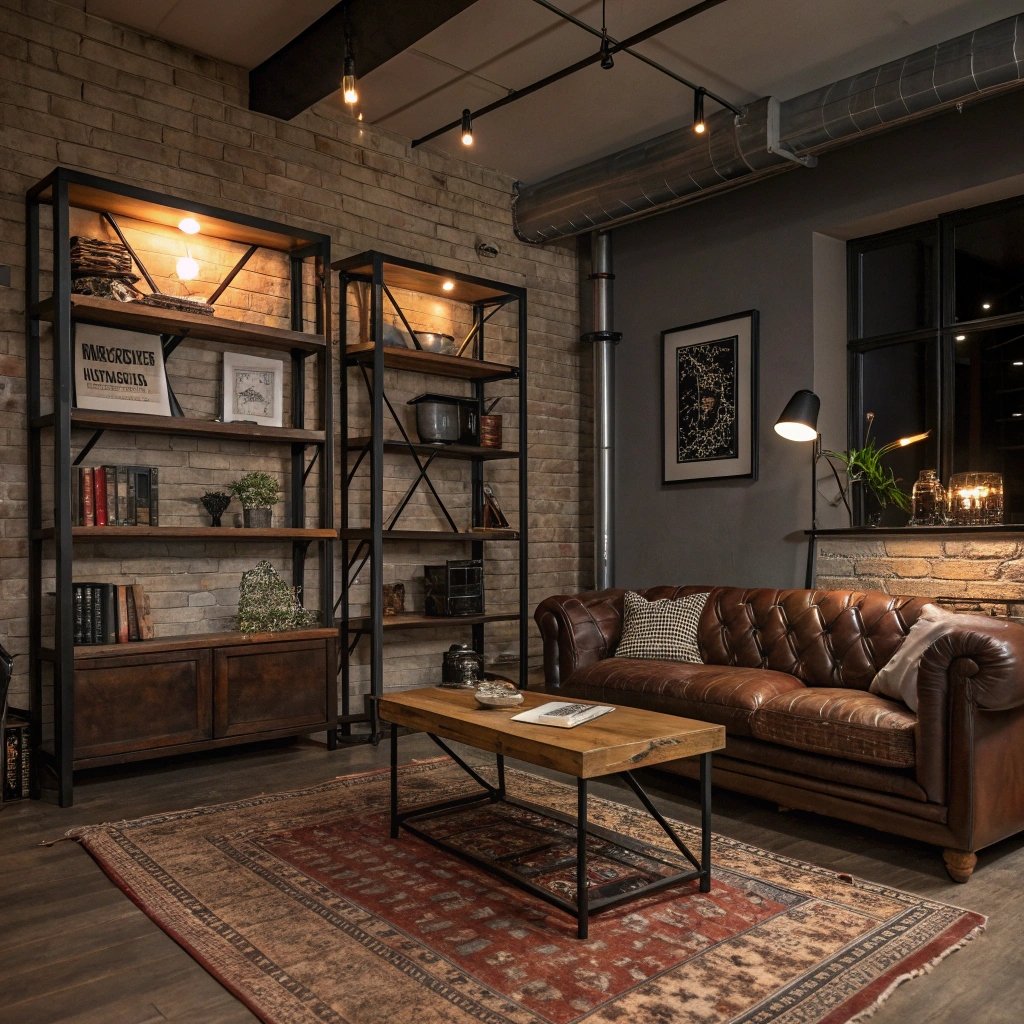
Balance workhorse materials with warmth: black steel, aged leather, concrete or plaster, and reclaimed wood. Keep silhouettes clean and let patina speak.
Add a vintage rug for comfort, and dimmable factory-style sconces for flexible task-to-mood lighting.
What makes something unique:
Paint conduit to match walls so lines feel intentional. Pair industrial bones with generous textiles—linen drapery and wool throws—to soften acoustics. The contrast creates a space with charisma and real-life livability.
16) Lighting Layers & Smart Scenes
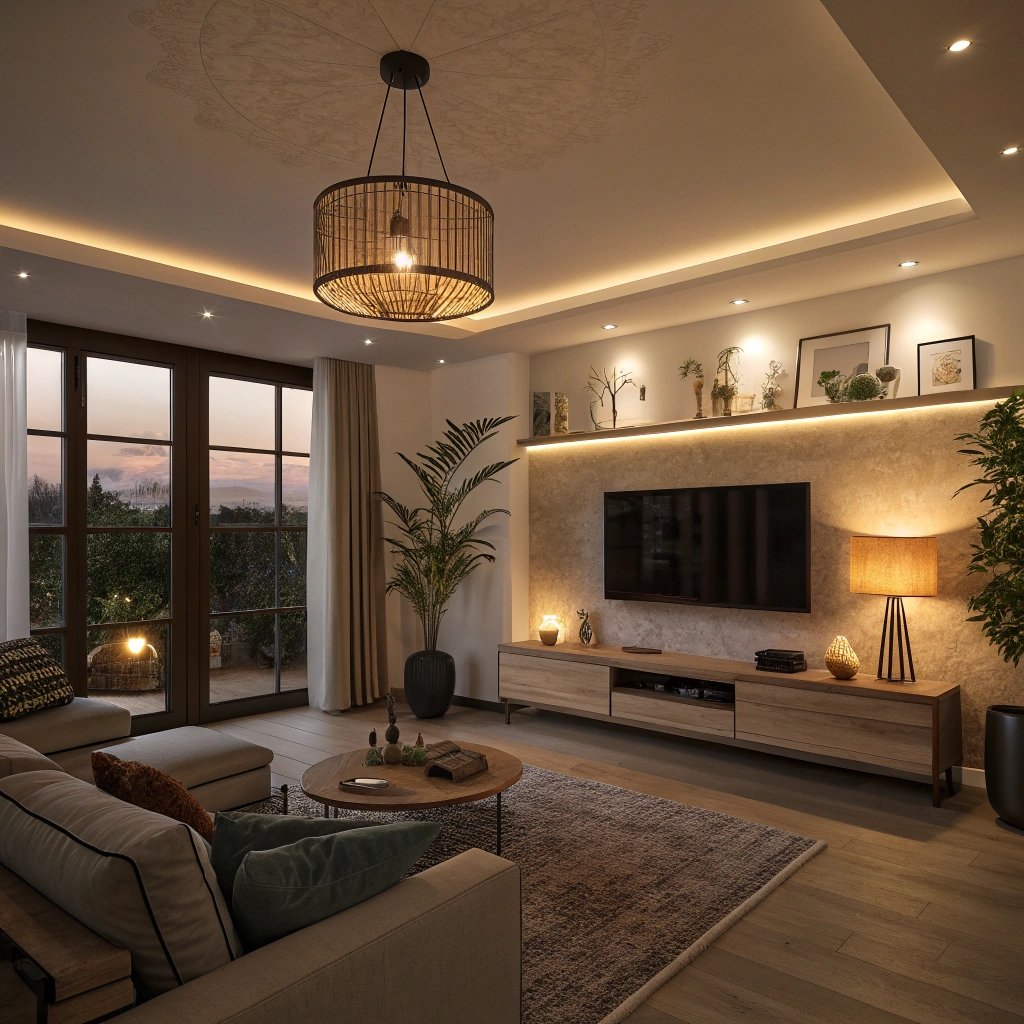
Plan lighting like a stage: ambient ceiling light, eye-level task lamps or sconces, and accents such as picture lights and toe-kick LEDs.
Warm 2700–3000K temperatures flatter skin and textiles. Put scenes on dimmers—Gather, Movie, Wind Down—so the room shifts with you.
What makes something unique:
Hide LED tape behind shelves or a soffit to graze walls and visually raise ceilings. Add a tiny uplight behind a plant for night drama.
When light becomes part of the decor, you can own fewer objects and the room still feels complete.
Quick Tips to Maximize Your Living Room Inspiration
Pick one hero move (feature wall, built-ins, or lighting) and support it with two simple tweaks.
Repeat materials and finishes deliberately to look curated, not crowded.
Edit shelves and surfaces quarterly—the best rooms are calm because storage actually works.

